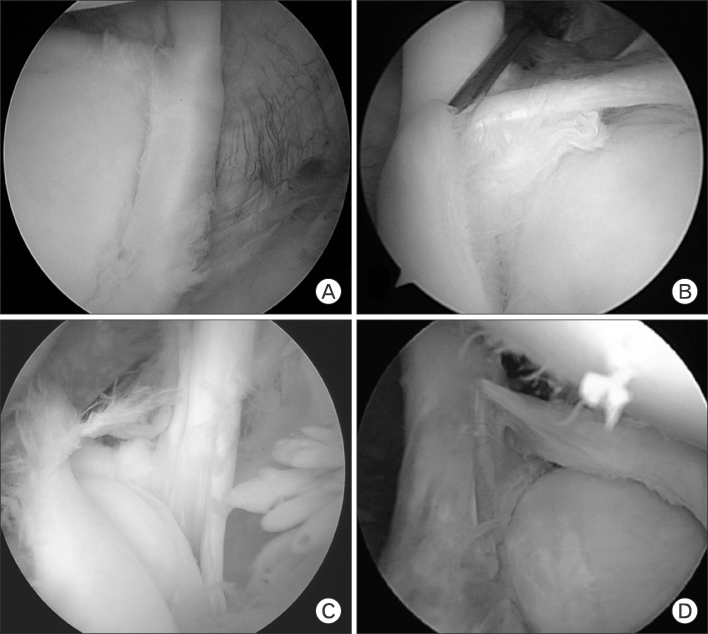Korean J Sports Med.
2017 Sep;35(2):91-96. 10.5763/kjsm.2017.35.2.91.
Impingement Syndrome and Labral Tear in Athletes: Differences in Diagnosis and Management with General Population
- Affiliations
-
- 1Department of Orthopaedic Surgery, Samsung Medical Center, Seoul, Korea. shoulderyoo@gmail.com
- KMID: 2389648
- DOI: http://doi.org/10.5763/kjsm.2017.35.2.91
Abstract
- The pathophysiology of impingement syndrome and labral tear was variable and not clear. In general populations, lesions occur mainly in acute cases. But in athletes, lesions are caused by repetitive exposure to excessive force, resulting in different patterns. For diagnosis, thorough physical examinations and radiologic findings should be combined. In athletes, conservative treatment including posterior capsular stretching and periscapular muscle strengthening is recommended as the first choice of treatment considering chronic progression and adaptive change. When choosing surgical treatment because of failure of conservative treatment, careful attention should be paid to the choice of repair or debridement of the rotator cuff partial tear, and the choice of the labral repair or biceps tenodesis.
MeSH Terms
Figure
Reference
-
1. Spiegl UJ, Warth RJ, Millett PJ. Symptomatic internal impingement of the shoulder in overhead athletes. Sports Med Arthrosc. 2014; 22:120–129.2. Griffin JW, Leroux TS, Romeo AA. Management of proximal biceps pathology in overhead athletes: what is the role of biceps tenodesis? Am J Orthop (Belle Mead NJ). 2017; 46:E71–E78.3. Drakos MC, Rudzki JR, Allen AA, Potter HG, Altchek DW. Internal impingement of the shoulder in the overhead athlete. J Bone Joint Surg Am. 2009; 91:2719–2728.4. Kibler WB, McMullen J. Scapular dyskinesis and its relation to shoulder pain. J Am Acad Orthop Surg. 2003; 11:142–151.5. Bigliani LU, Ticker JB, Flatow EL, Soslowsky LJ, Mow VC. The relationship of acromial architecture to rotator cuff disease. Clin Sports Med. 1991; 10:823–838.6. Burkhart SS, Morgan CD, Kibler WB. The disabled throwing shoulder: spectrum of pathology. Part I: pathoanatomy and biomechanics. Arthroscopy. 2003; 19:404–420.7. Burkhart SS, Morgan CD, Kibler WB. The disabled throwing shoulder: spectrum of pathology. Part II: evaluation and treatment of SLAP lesions in throwers. Arthroscopy. 2003; 19:531–539.8. Burkhart SS, Morgan CD, Kibler WB. The disabled throwing shoulder: spectrum of pathology. Part III: the SICK scapula, scapular dyskinesis, the kinetic chain, and rehabilitation. Arthroscopy. 2003; 19:641–661.9. Jobe CM. Posterior superior glenoid impingement: expanded spectrum. Arthroscopy. 1995; 11:530–536.10. Davidson PA, Elattrache NS, Jobe CM, Jobe FW. Rotator cuff and posterior-superior glenoid labrum injury associated with increased glenohumeral motion: a new site of impingement. J Shoulder Elbow Surg. 1995; 4:384–390.11. Meister K. Internal impingement in the shoulder of the overhand athlete: pathophysiology, diagnosis, and treatment. Am J Orthop (Belle Mead NJ). 2000; 29:433–438.12. Park JY, Yoo MJ, Kim MH. Comparison of surgical outcome between bursal and articular partial thickness rotator cuff tears. Orthopedics. 2003; 26:387–390.13. Sonnery-Cottet B, Edwards TB, Noel E, Walch G. Results of arthroscopic treatment of posterosuperior glenoid impingement in tennis players. Am J Sports Med. 2002; 30:227–232.14. Reynolds SB, Dugas JR, Cain EL, McMichael CS, Andrews JR. Debridement of small partial-thickness rotator cuff tears in elite overhead throwers. Clin Orthop Relat Res. 2008; 466:614–621.15. Pevny T, Hunter RE, Freeman JR. Primary traumatic anterior shoulder dislocation in patients 40 years of age and older. Arthroscopy. 1998; 14:289–294.16. Boone JL, Arciero RA. First-time anterior shoulder dislocations: has the standard changed? Br J Sports Med. 2010; 44:355–360.17. Snyder SJ, Karzel RP, Del Pizzo W, Ferkel RD, Friedman MJ. SLAP lesions of the shoulder. Arthroscopy. 1990; 6:274–279.18. Morgan CD, Burkhart SS, Palmeri M, Gillespie M. Type II SLAP lesions: three subtypes and their relationships to superior instability and rotator cuff tears. Arthroscopy. 1998; 14:553–565.19. Maffet MW, Gartsman GM, Moseley B. Superior labrumbiceps tendon complex lesions of the shoulder. Am J Sports Med. 1995; 23:93–98.20. Guanche CA, Jones DC. Clinical testing for tears of the glenoid labrum. Arthroscopy. 2003; 19:517–523.21. Edwards SL, Lee JA, Bell JE, et al. Nonoperative treatment of superior labrum anterior posterior tears: improvements in pain, function, and quality of life. Am J Sports Med. 2010; 38:1456–1461.22. Gorantla K, Gill C, Wright RW. The outcome of type II SLAP repair: a systematic review. Arthroscopy. 2010; 26:537–545.23. Boileau P, Parratte S, Chuinard C, Roussanne Y, Shia D, Bicknell R. Arthroscopic treatment of isolated type II SLAP lesions: biceps tenodesis as an alternative to reinsertion. Am J Sports Med. 2009; 37:929–936.
- Full Text Links
- Actions
-
Cited
- CITED
-
- Close
- Share
- Similar articles
-
- Ultrasonographic Usefulness for Diagnosis of Acetabular Labral Tear
- Anterior Impingement Syndrome of the Ankle
- Osteochondral Lesion of Humeral Head Associated with Shoulder Internal Impingement: Report of Three Cases
- Arthroscopic Labral Repair Associated with Femoroacetabular Impingement: Short Term 2-5 Years Follow-up Results
- Partial Thickness Tear of the Deep Surface of the Subscapularis Tendon: Its Relationship to the Anterior Internal Impingement



